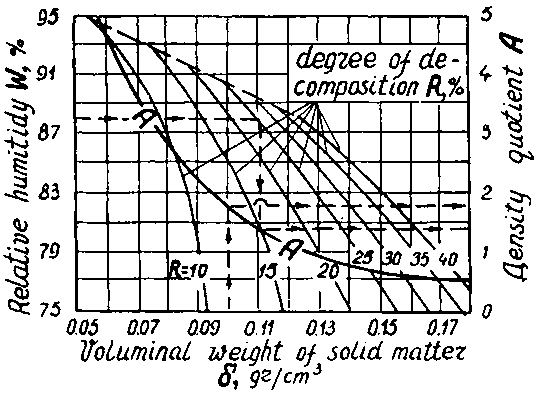(source Stephens et al. 1984)
In developing a mathematical model linking drainage depth and soil temperature that could be used to estimate subsidence of low moor peats in different climates, Stephens and Stewart (1976) applied the Arrhenius Law to both water-table and laboratory findings. (Arrhenius showed that the logarithm of the velocity coefficient, k, of a chemical reaction is linearly related to the reciprocal of the absolute temperature, T.) Stephens et al. (1984) then developed the “Stephens-Stewart-Chew” basic subsidence equation, which follows:
|
|
ST = (a+bD) ek(T-To) |
(1) |
|
ST |
= |
biochemical subsidence rate at temperature, T, |
|
D |
= |
depth of water-table, |
|
e |
= |
base of the natural logarithm, |
|
k |
= |
reaction rate constant, |
|
To |
= |
threshold soil temperature where biochemical action becomes
perceptible, a and b are constants. |
|
|
S(T+10) = Q10 x ST
= (a+bD)ek[(T+10)-To] |
(2) |
|
|
S(T+10) ÷ ST = Q10 =
e10k |
(3) |
|
|
k = 1 ÷ 10 in Q10 |
(4) |
|
|
ST = (a+bD)Q10[(T-To) ÷
10] |
(5) |
|
|
Sx = [-0.1035 + (0.0169 x D)] x
2[(Tx-5) - 10] |
(6) |
|
|
SL = [-0.1035+(0.0169 x 90)] x 2[(8.5-5.0)
÷ 10] |
|
|
|
SL = 1.4175 x 20.35 |
(7) |
|
|
SL = 1.4175 x 1.27 = 1.80 cm per year |
|
If the Everglades soils were in a more tropical climate where the average soil temperature was 30°C, for example, again from (6)
|
|
Sx = [-0.1035 + (0.0169 x 90)] x 2[(30-5)
÷ 10] |
(8) |
|
|
Sx = 8.02 cm per year |
|
For convenience in estimating Sx for any selected temperature, Tx, the results from equation (6) were plotted at water-table depths, D, of 30, 60, 90 and 120 cm, which has been reproduced as Figure 20.
Stephens and Stewart (1976) cite the shortage of field and laboratory data as a limitation of the mathematical model, but also point out that if future studies indicate that the values of Q10 and To should be adjusted the mathematical procedure for computations is still valid. Only the constants for a and b would change. For instance, where Q10 = 1.5 and To = 0°C, then a = -0.1523, and b = 0.0246.
When using equation (6) or the graph, Figure 21, remember these values were developed from organic soils with a mineral content of less than 15 percent and a bulk density of approximately 0.22 g/cm3 In muck soils with a greater mineral content and higher bulk density, the expected subsidence rates, depending on the increase in mineral content, will be between one-half and three-quarters of those shown by Figure 21 or equation (b).
Calculation of the Surface Compression of a Bog
(Source Murashko 1969)
The process of surface compression of a bog with time may be described by the following differential equation:
|
|
-dH ÷ dt = KhH |
(1) |
|
-dH ÷ dt |
the speed of compression in metres per year (the negative sign
shows that compression decreases with time), |
|
H |
the depth of the bog, in metres, |
|
h |
the depth of drains, in metres, |
|
t |
the duration of drainage, in years, |
|
K |
“the constant” of compression, the quotient which
depends on the physical properties of peat, in metres per year. |
|
|
Sn = AHo{l-exp[-h(a+bt)]} |
(2) |
|
A |
is the quotient of peat density, which depends on the volume
weight of the solid matter; |
|
Ho |
is the thickness of peat before draining, in metres; |
|
a and b |
experimental quotients (a = 0.07m-1;b =
0.06m-1, year-1). |
Equation (2) is correct when t³1 and the constant depth of water in drains is ho = 5-40 cm. If the designed depth of water in the canal is assumed to be more than the above mentioned value, the canal depth h be reduced by the value of the excess. For example, if h = 2.5m and ho = 1.0m, then the value of h = 2.5 - (1.0 - 0.4) or 1.9 m, which should be used in equation (2). This assumption is based on the fact that when the water-table of the bog is constantly near the canal borders the compression of peat will not take place.
Values of the quotient of peat density. A, are defined by the value of volume weight of solid matter according to the monogram (Fig. 38). The magnitude of the volume weight of dry peat should be defined by selection of samples with intact structure taken through the whole depth of the peat bog. In case the peat layer is inhomogeneous, such as when there are different layers with thickness of l1, l2,..., ln with different density through the depth of the bog, then the volume weight of the solid matter should be defined as a “mean weighted value”.
|
|
d = (d1l1 + d2l2 +
... + dnln) - (l1 - l2 + ... +
ln) |
(3) |
Figure 38. Momogram for choosing peat bog density quotient A

Since it is difficult to define the weight of solid matter of an undrained layer under production conditions, it is possible to choose values of A by means of the value of natural humidity, W, and the degree of decomposition, R. Determination of W and R is made by selecting samples with disturbed structure through the whole peat thickness. The nomogram (Fig. 38) also shows the method of defining the quotient A by these factors.